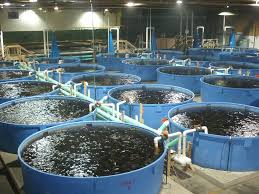10 SMART WAYS TO REDUCE PRODUCTION COSTS IN CATFISH FARMING
Catfish farming can be a profitable venture, but rising production costs can eat into your margins. To maintain a healthy bottom line, it’s essential to implement strategies that reduce expenses while maintaining the quality and health of your fish. In this blog post, we’ll explore some smart and practical ways to cut production costs in catfish farming.
1. Efficient Pond Management
 Learn More
Learn MoreProper pond management not only improves fish health but also helps control costs:
Regularly monitor water quality to prevent diseases and minimize treatment costs.
Implement aeration systems to improve oxygen levels and fish growth.
Use natural biological controls like aquatic plants and beneficial microorganisms to maintain water quality.
2. Select Suitable Catfish Species
Choose catfish species that are well-suited to your local environment and market demands. Some species may require less input and exhibit better growth rates, leading to cost savings.Optimize Feeding Practices
One of the most significant expenses in catfish farming is feed. To reduce costs without compromising fish health and growth, consider the following:
Use high-quality, cost-effective feed.
Implement a feeding regimen that matches the nutritional needs of your catfish.
Avoid overfeeding, which can lead to wastage and water quality issues.
READ ALSO 9 good reasons why you need knowledge to succeed in catfish farming business
3. Efficient Pond Management
Proper pond management not only improves fish health but also helps control costs:
Regularly monitor water quality to prevent diseases and minimize treatment costs.
Implement aeration systems to improve oxygen levels and fish growth.
Use natural biological controls like aquatic plants and beneficial microorganisms to maintain water quality.

4. Optimize Feeding Practices
One of the most significant expenses in catfish farming is feed. To reduce costs without compromising fish health and growth, consider the following:
Use high-quality, cost-effective feed.
Implement a feeding regimen that matches the nutritional needs of your catfish.
Avoid overfeeding, which can lead to wastage and water quality issues.
5. Select Suitable Catfish Species
Choose catfish species that are well-suited to your local environment and market demands. Some species may require less input and exhibit better growth rates, leading to cost savings.
READ ALSO 15 ways to keep your catfish clean at all times
6. Minimize Energy Consumption
Energy costs can be a significant part of your expenses. To reduce them:
Invest in energy-efficient equipment for pond aeration and water circulation.
Use renewable energy sources like solar power where feasible.
Implement energy-saving practices, such as proper insulation for hatcheries or fish processing facilities.
7. Implement Biosecurity Measures
Preventing diseases is more cost-effective than treating them. Develop and enforce strict biosecurity protocols:
Quarantine new fish arrivals to prevent the introduction of diseases.
Control access to your farm to limit the risk of contamination.
Practice good hygiene and disinfection routines for equipment and personnel.
8. Effective Record Keeping
Maintaining accurate records can help you identify areas where costs can be reduced:
Track expenses meticulously to identify where savings can be made.
Monitor fish growth, feed conversion ratios, and mortality rates to fine-tune your operations.
ATTENTION: Click “HERE” to join our WhatsApp group and receive More updates directly on your WhatsApp!
9. Economical Labor Management
Labor costs can be optimized through efficient management practices:
Cross-train your staff to perform multiple tasks.
Implement time-saving technologies and automation where possible.
Consider outsourcing specific tasks, such as maintenance, on an as-needed basis.
10. Bulk Purchasing and Negotiating Deals
When buying feed, equipment, or other supplies, negotiate with suppliers for better deals. Purchasing in bulk can often lead to significant cost savings.
Conclusion:
Reducing production costs in catfish farming is not about cutting corners but making informed decisions that enhance efficiency and profitability. By optimizing feeding practices, managing ponds effectively, selecting suitable species, minimizing energy consumption, enforcing biosecurity measures, maintaining accurate records, managing labor efficiently, and negotiating deals with suppliers, you can strike a balance between cost reduction and maintaining a high-quality catfish farming operation. With these strategies in place, you’ll be better positioned to navigate the challenges of catfish farming while ensuring a healthy bottom line.















